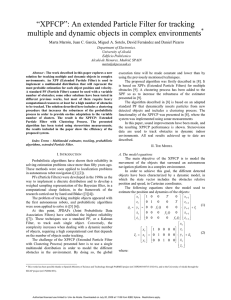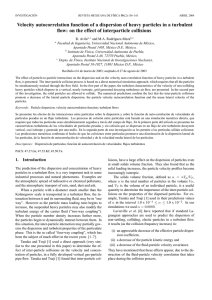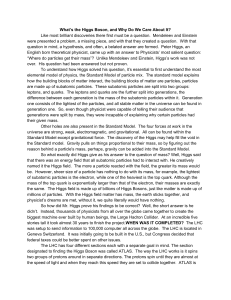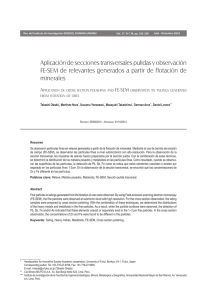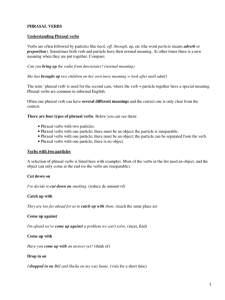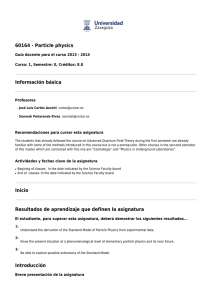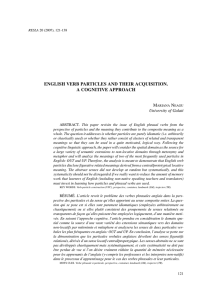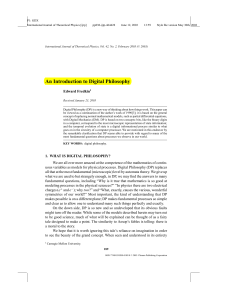The four particles paradox in special relativity
Anuncio
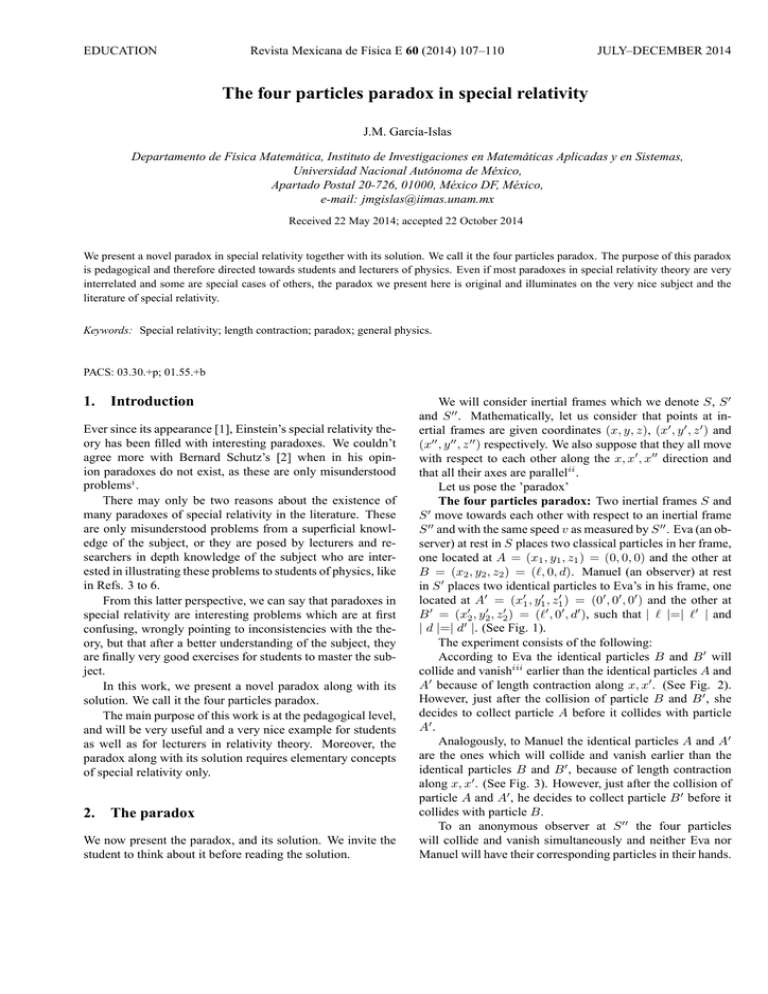
EDUCATION Revista Mexicana de Fı́sica E 60 (2014) 107–110 JULY–DECEMBER 2014 The four particles paradox in special relativity J.M. Garcı́a-Islas Departamento de Fı́sica Matemática, Instituto de Investigaciones en Matemáticas Aplicadas y en Sistemas, Universidad Nacional Autónoma de México, Apartado Postal 20-726, 01000, México DF, México, e-mail: jmgislas@iimas.unam.mx Received 22 May 2014; accepted 22 October 2014 We present a novel paradox in special relativity together with its solution. We call it the four particles paradox. The purpose of this paradox is pedagogical and therefore directed towards students and lecturers of physics. Even if most paradoxes in special relativity theory are very interrelated and some are special cases of others, the paradox we present here is original and illuminates on the very nice subject and the literature of special relativity. Keywords: Special relativity; length contraction; paradox; general physics. PACS: 03.30.+p; 01.55.+b 1. Introduction Ever since its appearance [1], Einstein’s special relativity theory has been filled with interesting paradoxes. We couldn’t agree more with Bernard Schutz’s [2] when in his opinion paradoxes do not exist, as these are only misunderstood problemsi . There may only be two reasons about the existence of many paradoxes of special relativity in the literature. These are only misunderstood problems from a superficial knowledge of the subject, or they are posed by lecturers and researchers in depth knowledge of the subject who are interested in illustrating these problems to students of physics, like in Refs. 3 to 6. From this latter perspective, we can say that paradoxes in special relativity are interesting problems which are at first confusing, wrongly pointing to inconsistencies with the theory, but that after a better understanding of the subject, they are finally very good exercises for students to master the subject. In this work, we present a novel paradox along with its solution. We call it the four particles paradox. The main purpose of this work is at the pedagogical level, and will be very useful and a very nice example for students as well as for lecturers in relativity theory. Moreover, the paradox along with its solution requires elementary concepts of special relativity only. 2. The paradox We now present the paradox, and its solution. We invite the student to think about it before reading the solution. We will consider inertial frames which we denote S, S 0 and S 00 . Mathematically, let us consider that points at inertial frames are given coordinates (x, y, z), (x0 , y 0 , z 0 ) and (x00 , y 00 , z 00 ) respectively. We also suppose that they all move with respect to each other along the x, x0 , x00 direction and that all their axes are parallelii . Let us pose the ’paradox’ The four particles paradox: Two inertial frames S and S 0 move towards each other with respect to an inertial frame S 00 and with the same speed v as measured by S 00 . Eva (an observer) at rest in S places two classical particles in her frame, one located at A = (x1 , y1 , z1 ) = (0, 0, 0) and the other at B = (x2 , y2 , z2 ) = (`, 0, d). Manuel (an observer) at rest in S 0 places two identical particles to Eva’s in his frame, one located at A0 = (x01 , y10 , z10 ) = (00 , 00 , 00 ) and the other at B 0 = (x02 , y20 , z20 ) = (`0 , 00 , d0 ), such that | ` |=| `0 | and | d |=| d0 |. (See Fig. 1). The experiment consists of the following: According to Eva the identical particles B and B 0 will collide and vanishiii earlier than the identical particles A and A0 because of length contraction along x, x0 . (See Fig. 2). However, just after the collision of particle B and B 0 , she decides to collect particle A before it collides with particle A0 . Analogously, to Manuel the identical particles A and A0 are the ones which will collide and vanish earlier than the identical particles B and B 0 , because of length contraction along x, x0 . (See Fig. 3). However, just after the collision of particle A and A0 , he decides to collect particle B 0 before it collides with particle B. To an anonymous observer at S 00 the four particles will collide and vanish simultaneously and neither Eva nor Manuel will have their corresponding particles in their hands. 108 J.M. GARCÍA-ISLAS F IGURE 1. Inertial systems S and S 0 moving towards each other at speed v, as seen from an inertial frame S 00 . Particles A and B are drawn as seen by observer at S and particles A0 and B 0 are drawn as seen by observer at S 0 . So, how is it possible that Eva has in her hand particle A if Manuel saw it vanished when it hit particle A0 ? In the same way, how is it possible that Manuel has in his hand particle B 0 if Eva saw it vanished when it hit particle B? How is it possible that to the anonymous observer neither Eva nor Manuel have a particle in their hands. Who is right? In other words; Eva will claim she has the A particle in her hand and that particle B and B 0 have vanished. Manuel will claim he has the B 0 particle in his hand and that particle A0 and A have vanished. The anonymous observer will claim the four particles have vanished. 2.1. The solution Let us now present the solutioniv . We will use basic special relativity concepts only. Due to the addition of velocities in special relativity, Eva and Manuel are moving towards each other at speed w= 2v 1 + v2 (1) According to Eva, particles at Manuel’s frame are longitudi- nally separated a distance L = `0 p 1 − w2 (2) due to length contraction along the direction of motion. Moreover, they are vertically separated a distance | d |=| d0 |, since there is no contraction along the perpendicular direction of motion. Therefore, according to Eva, the identical particles B and B 0 will collide and vanish earlier than the identical particles A and A0 . Just after the collision of particle B and B 0 , she decides to collect particle A before it collides with particle A0 . Analogously, Manuel will observe particles at Eva’s frame longitudinally separated a distance p L0 = ` 1 − w 2 (3) due to length contraction along the direction of motion. Moreover, they are vertically separated a distance | d |=| d0 |, since there is no contraction along the perpendicular direction of motion. F IGURE 2. Inertial system S 0 moving towards S at speed w. Particles A0 and B 0 as seen by observer at S. Rev. Mex. Fis. E 60 (2014) 107–110 109 THE FOUR PARTICLES PARADOX IN SPECIAL RELATIVITY F IGURE 3. Inertial system S moving towards S 0 at speed w. Particles A and B as seen by observer at S 0 . Therefore, according to Manuel, the identical particles A and A0 will collide and vanish earlier than the identical particles B and B 0 . Just after the collision of particle A and A0 , he decides to collect particle B 0 before it collides with particle B. Let us now see that it is not possible that Eva collects particle A before it collides with particle A0 . Particles A and A0 will collide and vanish before she prevents them from colliding. And the same applies to Manuel, it is not possible that he collects particle B 0 before it collides with particle B. Particles B and B 0 will collide and vanish before he prevents them from colliding. If Eva were located just where her A particle is situatedv , then this is what happens. Recall that in special relativity all signal information is transmitted, at most, at the speed of light. Therefore, when particle B and B 0 collide and vanish, a clock situated at the point of collision will read t0 = 0. Then, Eva will have knowledge of this collision when light coming from the point of collision gets to her. The point of collision of particles B and B 0 is separated √ 2 from particle A a distance r = ` + d2 . Therefore, information about the collision of√particles B and B 0 will reach Evavii at proper time t1 = `2 + d2 . It will be enough to consider the longitudinally separation of the point of collision of particles B and B 0 and particle A given by ` so that 0 information of the collision of √ particles B and B will reach 2 2 Eva at proper time t1 = ` < ` + d . From Eva’s point of view, at the moment of collision of particles B and B 0 , particles A and A0 are longitudinally located a distance D apart given by p D =| ` | − | L |=| ` | − | `0 | 1 − w2 h i p p =| ` | − | ` | 1 − w2 =| ` | 1 − 1 − w2 (4) and therefore particles A and A0 will collide and vanish at Eva’s proper time given by √ £ ¤ ` 1 − 1 − w2 D = (5) t2 = w w It can easily be checked that t2 < t1 . Let us check this strict inequality √ ¤ £ ` 1 − 1 − w2 <` w h i p ⇒ 1 − 1 − w2 < w p ⇒ − 1 − w2 < w − 1 ⇒ 1 − w2 > [1 − w]2 ⇒ 0 > 2w[w − 1] (6) and this latter inequality is true, since w < 1. Therefore, particles A and A0 will collide and vanish before Eva knows that particles B and B 0 have collided, and therefore, she cannot collect particle A before it collides with particle A0 . By the time she knows that particle B and B 0 have collided, particles A and A0 will also be vanished. The same method applies to Manuel with the conclusion that he will not be able to collect particle B 0 before it collides with particle B, since by the time he realises about the collision of particles A and A0 , particles B and B 0 will be vanished. The paradox is solved. Neither Eva, nor Manuel will have collected a particle, thus agreeing with the anonymous observer. The paradox we presented here can be seen as a smart variation of the two colliding inclined rods paradoxvii presented in Ref 7. However the solution presented here deals with pure simple relativistic concepts. It does not involve the idea of ’extended present’ as invoked to solve the paradox in Ref 7. In our opinion the term ’extended present’ does not exist. The solution we presented here solves both, the four particles paradox and the one presented in Ref 7. It can easily be seen that in terms of the space-time geometry the observer at S concludes that the separation of the events corresponding to the collision of particles B and B 0 and the collision of particles A and A0 is space-like, as well as the observer at S 0 concludes that the separation of the events corresponding to the collision of particles A and A0 and the collision of particles B and B 0 is also space-like. Rev. Mex. Fis. E 60 (2014) 107–110 110 J.M. GARCÍA-ISLAS It is a trivial exercise (for students) to find the Lorentz transformation between the inertial frame S and S 0 which sends the space-like separated events at S into the space-like separated events at S 0 . Recall that Lorentz transformations send space-like vectors into space-like vectorsviii . vii. Compare with [7]. i. See Ref. 2, pages 23-24. ii. It is important to mention that we only need two spatial dimensions to describe the problem. However, we stick to three spatial dimensions for aesthetic reasons. Just because physical objects such as trains, spaceships, cars, which are represented by inertial frames, are three dimensional. iii. Throughout this article, particles will refer to classical particles, not to quantum ones. And when we say that they vanish as they collide, it means that they will scatter and the observer will no longer see them. iv. We insist one more time to the student to think of the solution before reading it. v. Like sitting on top of it, so that she collects it as fast as possible. vi. In units where c = 1. To sum up, the paradox has been solved using only basic concepts of special relativity, and it is suitable to be presented as a good exercise for students. It illuminates on the subject of relativity and can be used at the pedagogical level by teachers in the area. viii. It also sends time-like vectors into time-like vectors and null vectors into null vectors. 1. A. Einstein, Annalen der Physik 17 (1905) 891921. 2. B. Schutz, A First Course in General Relativity (Cambridge University Press, Second Edition, 2009). 3. W. Rindler, Am. J. Phys. 29 (1961) 365. 4. Øyvind Grøn, S. Johannesen, Eur. J. Phys. 14 (1993) 97-100. 5. Øyvind Grøn, Phys. Scr. 87 (2013) 035004. 6. R. Cacioppo, A. Gangopadhyaya, Physics Education 47 (2012) 563-567. 7. Ch. lyer, G.M. Prabhu, Eur. J. Phys 27 (2006) 819-824. Rev. Mex. Fis. E 60 (2014) 107–110


